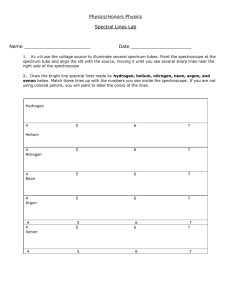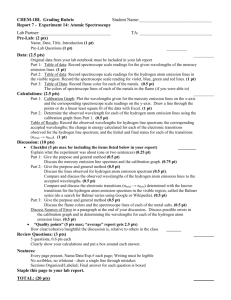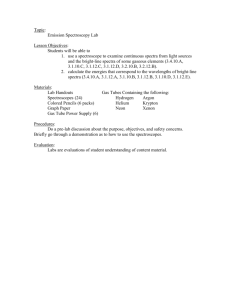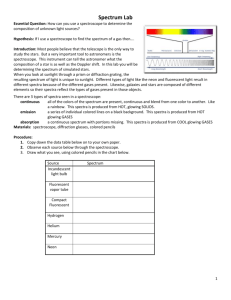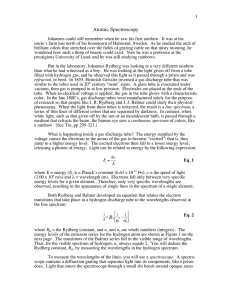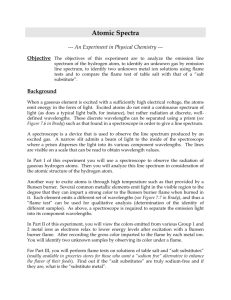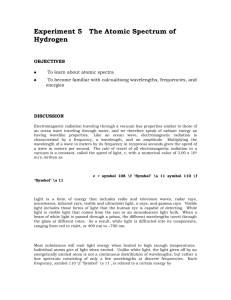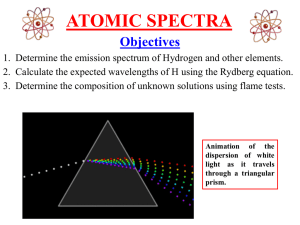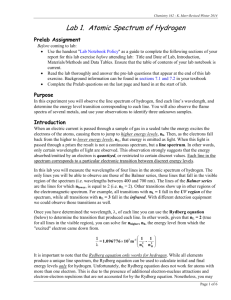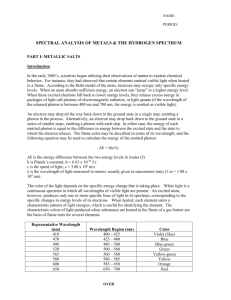Emission Spectra & Bohr Model Lab Report
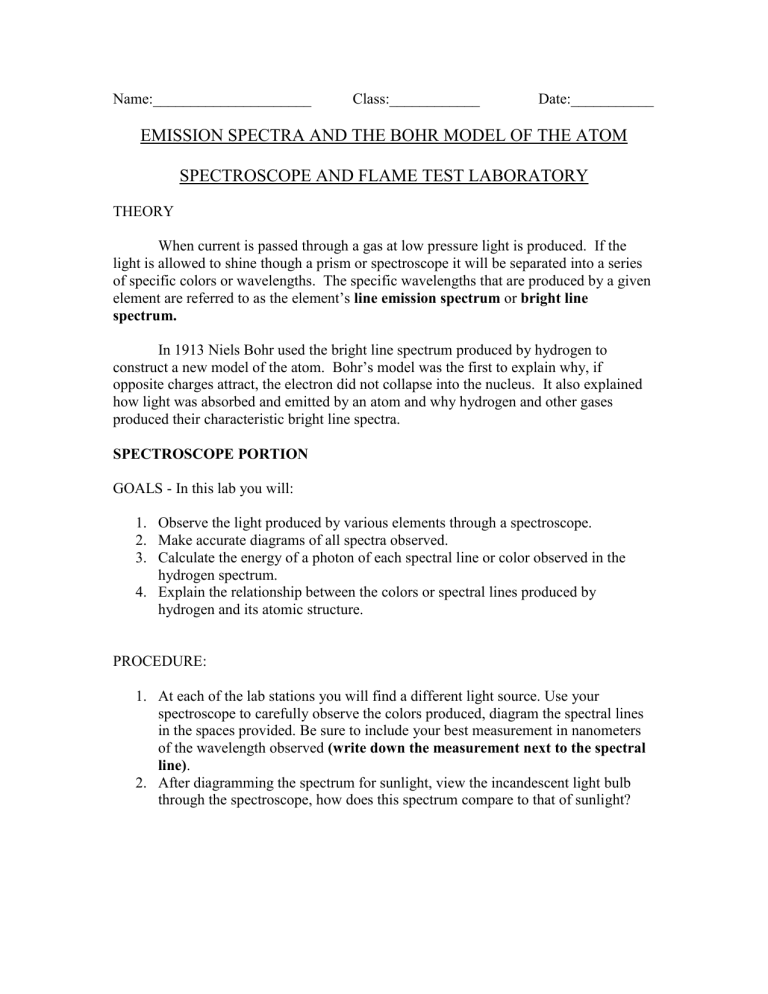
Name:_____________________ Class:____________ Date:___________
EMISSION SPECTRA AND THE BOHR MODEL OF THE ATOM
SPECTROSCOPE AND FLAME TEST LABORATORY
THEORY
When current is passed through a gas at low pressure light is produced. If the light is allowed to shine though a prism or spectroscope it will be separated into a series of specific colors or wavelengths. The specific wavelengths that are produced by a given element are referred to as the element’s line emission spectrum or bright line spectrum.
In 1913 Niels Bohr used the bright line spectrum produced by hydrogen to construct a new model of the atom. Bohr’s model was the first to explain why, if opposite charges attract, the electron did not collapse into the nucleus. It also explained how light was absorbed and emitted by an atom and why hydrogen and other gases produced their characteristic bright line spectra.
SPECTROSCOPE PORTION
GOALS - In this lab you will:
1.
Observe the light produced by various elements through a spectroscope.
2.
Make accurate diagrams of all spectra observed.
3.
Calculate the energy of a photon of each spectral line or color observed in the hydrogen spectrum.
4.
Explain the relationship between the colors or spectral lines produced by hydrogen and its atomic structure.
PROCEDURE:
1.
At each of the lab stations you will find a different light source. Use your spectroscope to carefully observe the colors produced, diagram the spectral lines in the spaces provided. Be sure to include your best measurement in nanometers of the wavelength observed (write down the measurement next to the spectral line) .
2.
After diagramming the spectrum for sunlight, view the incandescent light bulb through the spectroscope, how does this spectrum compare to that of sunlight?
DATA:
Incandescent Light Bulb -
6.5x10
-7 m=650 nm 600 nm 550 nm 500 nm 450 nm
Hydrogen (H) -
650 nm 600 nm 550 nm 500 nm 450 nm
Sodium (Na) -
650 nm 600 nm 550 nm 500 nm 450 nm
Mercury (Hg) -
650 nm 600 nm 550 nm 500 nm 450 nm
Unknown -
650 nm 600 nm 550 nm 500 nm 450 nm
CALCULATIONS: always show work clearly!
1.
What is the relationship ( equation ) between the wavelength of a color and its frequency? What does each of the variables in the equation stand for?
2.
Use your wavelength measurements of each of hydrogen’s spectral lines (make sure to have at least 3 lines) to calculate the frequency of each color. Show your work and be sure to express your wavelengths in nanometers. (Speed of light =
3.0 x 10 8 m/s)
3.
The relationship between the frequency of a color and the energy of its photons is
E = hf. What does each of the variables stand for? What is the value of Planck’s constant?
4.
Use the information generated in questions (2) and (3) to calculate the energy of photon of each hydrogen spectral line.
ANALYSIS: (You may need to use the text in some cases*)
1.
How do your measurements for each of the bright line spectra compare to those in the following websites? Are they accurate? Explain. http://astro.u-strasbg.fr/~koppen/discharge/ http://chemistry.bd.psu.edu/jircitano/periodic4.html
2.
What do you think the gas was in the uncoated fluorescent bulb? Why?
3.
Describe the changes that occur in an atom when an electric current is passed through it and it emits light.
4.
Why does hydrogen emit only certain specific colors, wavelengths or frequencies of light? Explain.
5.
Why do you think Bohr used the hydrogen atom as the basis for his model?
6.
Why do you think different elements have vastly different spectra? Can you explain this using what you have learned in this activity?
7.
Make a diagram that illustrates what is going on in the hydrogen atom when it emits light.
FLAME TEST PORTION
The flame test is used to visually determine the identity of an unknown metal of an ionic salt based on the characteristic color the salt turns the flame of a bunsen burner.
GOALS - In this lab you will:
1.
Investigate the relationship between atomic structure and emission of light.
2.
Identify an unknown metal by means of a flame test and bright line spectrum.
Procedure:
1.
Set up a Bunsen Burner and adjust the flame.
2.
Dip a wooden splint into the solution to be tested. Hold the splint in the flame for a brief period of time and observe the color of the flame.
3.
DO NOT PLACE ON TABLE TOP. This will contaminate the solutions.
4.
Repeat this procedure with the remaining solutions and unknown solutions A and
B.
5.
Additional splints may be used to confirm the identities of unknown solutions A and B. A bright line spectrum may also be obtained by use of a spectroscope.
Record the wavelengths of the lines.
6.
Clean up and wipe down your work space.
Data Table:
Ion
Ba
2+
Na
Li
Sr
+
+
2+
Observations
Ca
2+
K
+
Cu
2+
Unknown
A
Unknown
B
ANALYSIS:
1.
What are the identities of the unknown solutions A and B? How could you tell?
2.
What is happening (at the sub-atomic level) that causes the colored light that you observe?
3.
Why do different elements produce different colored flames?
Name:_____________________ Class:____________ Due Date:___________
EMISSION SPECTRA AND THE BOHR MODEL OF THE ATOM
SPECTROSCOPE AND FLAME TEST LABORATORY
GRADING RUBRIC
SAFETY/PRE-LAB QUIZ . . . . . . . . . . . . . . . . . . . . . . . . . . . . . . . .______/12 pts.
LAB BEHAVIOR AND PARTICIPATION . . . . . . . . . . . . . . . . . . . ______/4 pts.
SPECTROSCOPE PORTION
DATA . . . . . . . . . . . . . . . . . . . . . . . . . . . . . . . . . . . . . . . . . . . . . . . .______/24 pts.
CALCULATIONS . . . . . . . . . . . . . . . . . . . . . . . . . . . . . . . . . . . . . . ______/12 pts.
ANALYSIS . . . . . . . . . . . . . . . . . . . . . . . . . . . . . . . . . . . . . . . . . . . .______/14 pts.
FLAME TEST PORTION
DATA . . . . . . . . . . . . . . . . . . . . . . . . . . . . . . . . . . . . . . . . . . . . . . . . ______/11 pts.
ANALYSIS . . . . . . . . . . . . . . . . . . . . . . . . . . . . . . . . . . . . . . . . . . . . .______/8 pts.
TOTAL POINTS . . . . . . . . . . . . . . . . . . . . . . . . . . . . . . . . . . . . . . . . . . . . . .______/85 pts.

